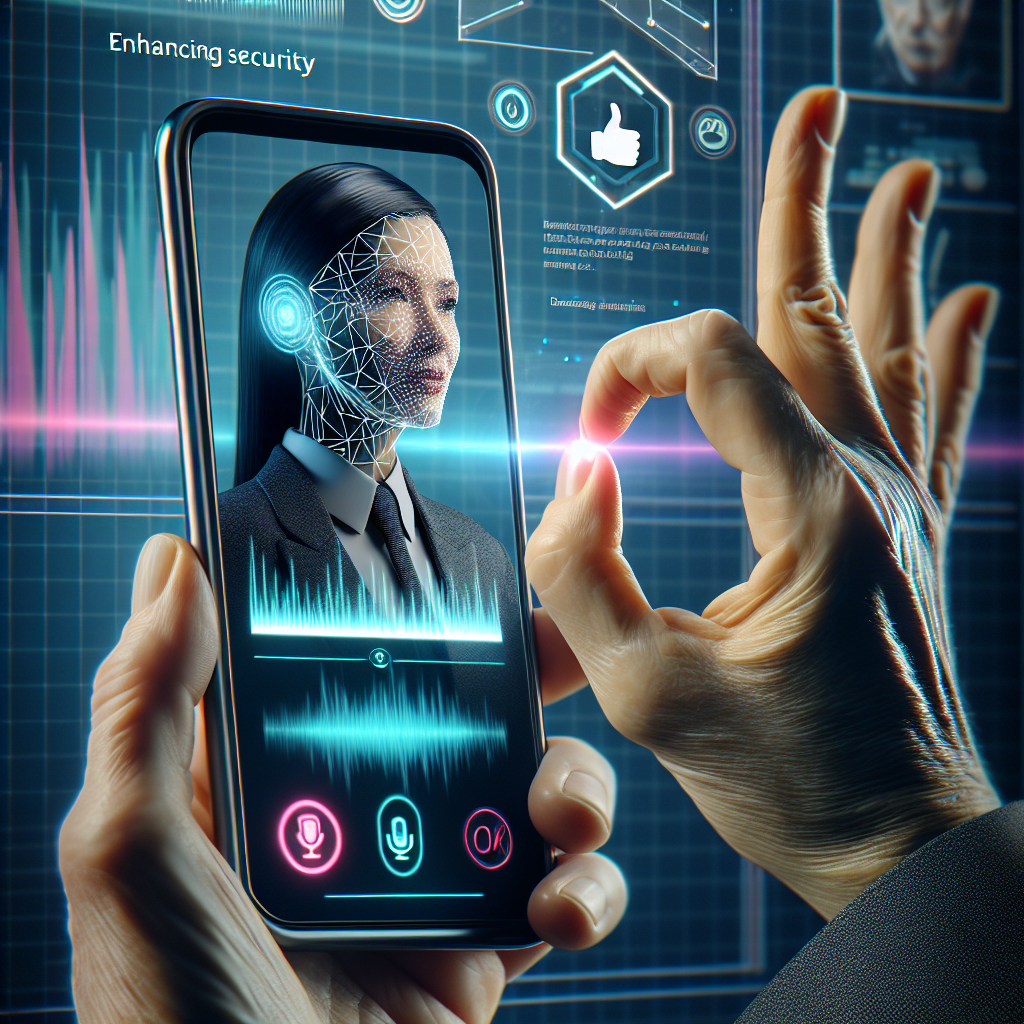
Welcome to the fascinating world of Voice Biometrics, a powerful tool reshaping the security landscape in the telecommunication industry. It revolves around a unique aspect of human identity—the voice. By analysing the distinct features of a person's voice, this technology provides an additional layer of security in phone transactions.

At its core, voice biometrics is a subclass of speaker recognition that utilizes personalized vocal characteristics such as pitch, tone, and speed for authentication and identification purposes. It works by recording a caller's vocal input, converting the voice into a digital model, and comparing it with pre-existing voice samples. As a result, it can accurately identify and authenticate the caller based on their unique voiceprint.
The strength of Voice Biometrics lies in its ability to provide a smooth and non-intrusive method of authentication in phone transactions. To an ordinary person, the transaction process remains unchanged—they have a normal conversation. In the background, however, their voice signature is checked and verified against the stored voiceprint. This, therefore, reduces the risk of fraud while enhancing overall call security.
In the era of digital transformation, Voice Biometrics has found its place in a wide range of industries including banking, insurance, and customer care services, effectively safeguarding their phone transactions against unauthorized access. With consistent advancements in AI technology, the effectiveness, accuracy, and efficiency of voice biometric solutions are set to further improve.
As digital transactions continue to increase, securing phone transactions has become a growing concern for many businesses. In an effort to enhance security measures, several companies are turning to a powerful duo: Artificial Intelligence and Voice Biometrics. By integrating these technologies, businesses can ensure more secure, accurate, and efficient transactions.
Voice biometrics technology uses unique voice features to authenticate individuals' identities. However, traditional voice biometrics systems encounter limitations such as noise and fluctuations in voice patterns. This is where AI comes into play. By enhancing voice biometrics with Artificial Intelligence, businesses can overcome these challenges, achieving higher accuracy and robustness.
AI can effectively learn and analyze the nuances of individual voices, identifying unique vocal patterns, accents, and speech rhythms. This, coupled with speech recognition and natural language processing capabilities, allows AI-driven voice biometrics systems to authenticate users even in noisy environments or during minor illnesses that may slightly alter a person’s voice.
Furthermore, AI integrated with voice biometrics provides more than just an added layer of security. It offers an enhanced customer experience by enabling smooth, frictionless transactions. Customers no longer need to remember complex security questions or passwords. They can verify their identities simply by speaking, allowing for a more natural and convenient interaction.
In conclusion, the integration of AI and voice biometrics provides a potent solution for securing phone transactions. This innovative technology not only addresses security concerns but also improves operational efficiency and the overall customer experience. As AI continues to evolve and become more sophisticated, we can expect even more secure and user-friendly systems in the future.
The prolific growth of artificial intelligence (AI) technologies has revolutionized numerous sectors, and the domain of phone transactions is no exception. One of the most game-changing innovations is AI-enhanced voice biometrics, a sophisticated technology that analyzes unique voice characteristics to verify a user's identity. This technology is increasingly being used to bolster security and improve the user experience in phone transactions.

One of the chief advantages of AI-enhanced voice biometrics is enhanced security. By utilizing the one-of-a-kind aspects of a user's voice—a feature as unique as a fingerprint—voice biometrics can significantly reduce the potential for unauthorized access or fraud. This innovative solution is not only safer but also more convenient than traditional methods like passwords or PINs, which can be easily forgotten or stolen.
Another key benefit is the improved customer experience. Users can carry out transactions quickly and smoothly, without the need to remember complex passwords or answer tedious security questions. The authentication process becomes swift and friction-free, preventing user frustration and thus improving customer retention. Studies have shown that customers prefer voice biometrics because of its speed and simplicity.
Moreover, AI-enhanced voice biometrics also leads to significant reduction in fraud. A report by the American Institute of CPAs (AICPA) suggests that voice biometrics can counteract various types of phone frauds, including impersonation and social engineering scams, making phone transactions safer for users and businesses alike.
While AI-enhanced voice biometrics may seem high-tech and complex, the advantages it brings in terms of security, customer experience, and fraud reduction are simple and clear. By integrating this technology into phone transactions, companies can not only protect their customers but also enhance their overall service.
As the application of AI and Voice Biometrics in securing phone transactions continues to expand, several challenges and considerations arise that can potentially hamper its full-fledged implementation. One of the primary concerns revolves around privacy issues. When we use voice biometrics, we are essentially sharing our unique voice prints – personal data that some may feel uncomfortable revealing. The General Data Protection Regulation(GDPR), for instance, mandates that businesses must securely process biometric data, including voice prints, and ensure that they are protected from misuse. Therefore, organizations need to seek informed consent from users before collecting and processing their voice data.
Another potential stumbling block is the accuracy of voice recognition systems. The performance of these systems can decline in noisy environments or when the user has a cold or a sore throat. Voice also tends to change with age, which needs to be taken into account. Research has shown that voice recognition systems can struggle to accurately identify individuals who are very young or very old.
In addition to these, there’s also the question of security. As advanced as voice biometric systems are, they are not impervious to attacks. There have been instances of voice synthesis and voice replay attacks, where a ‘fraudster’ mimics the voice of a genuine user or plays back a recorded voice to gain illegitimate access. Therefore it’s imperative that multi-factor authentication forms an integral part of any voice biometric implementation.
Finally, a major factor contributing to the relatively slow adoption of voice biometrics is the potential cost of implementation. Deploying voice recognition technologies can be a costly affair in terms of both capital and expertise. Many small and medium-sized businesses find the costs prohibitive and opt for traditional, less-secure forms of authentication instead.
These challenges demonstrate that there is still a long way to go for voice biometrics. However, the potential for enhancing security in phone transactions is huge, so the exploration and navigation of these obstacles is certainly a worthwhile endeavor.
There's a growing trend in leveraging AI and Voice Biometrics in various sectors, notably in banking, telecommunication, healthcare, and customer service. This technology, driven by the power of AI, provides an extra layer of security that assists in preventing fraud in phone transactions.

HSBC, the banking giant, has set a perfect example of effectively deploying voice biometrics in a real-world scenario. With HSBC's Voice ID, they were able to render an additional layer of security. This system can analyze over 100 unique characteristics of a customer's voice, thus offering enhanced security.
Orange, a leading telecom company, also revolutionized their customer service by introducing voice biomics. Their Nuance's Voice Biometric solution provides customers a hassle-free way to confirm their identity, thereby improving customer satisfaction while decreasing fraudulent activities.
Companies like Medtronic are driving change in the healthcare industry with AI-powered voice biometrics. This technology aids in patient authentication and access to confidential medical data over the phone, ensuring optimal data privacy.
In customer service, voice biometrics technology, powered by AI, is significantly boosting the customer experience by swiftly verifying user identities, significantly reducing call times.
In conclusion, these are just a few of the many inspiring examples showing how AI and Voice Biometrics are enhancing security in phone transactions in various industries.
As technology relentlessly marches forward, it leaves no stone unturned, including the field of security. Voice biometrics, a robust identification technique that recognizes an individual's unique physiological and behavioural patterns, seems destined to offer new dimensions of security for phone transactions. When authenticity matters, as in banking or telehealth applications, voice biometrics steps up as a superhero to defend against fraudsters.
Voice biometrics is already transcending numerous hurdles of conventional security methods. Unlike passwords and PINS, the voice signature of an individual cannot be easily replicated or stolen, hence increasing the reliability of this futuristic solution. But what does the future hold for voice biometric security?
Artificial Intelligence (AI) and Machine Learning (ML) are already shaping the future trends of voice biometrics. Progressive research in AI is enabling more advanced voice biometric systems that employ deep learning techniques to discern even minute nuances in voice patterns. ML algorithms will be able to deal with variances in an individual's voice due to age, health or emotional state, making voice biometrics even more precise and reliable.
Alongside, the convergence of voice biometrics with other technologies, such as blockchain, is anticipated. This will lead to highly secure, decentralised voice identity solutions. Furthermore, integration with devices like smart home systems and IoT will see wider adoption, as businesses and individuals recognize the unmatched security shield of voice biometrics.
In conclusion, relying on the uniqueness of an individual's voice, voice biometrics coupled with AI are set to revolutionize the realm of phone transaction security. Although the path is fraught with challenges, the promise it holds is unmatched. With the digital landscape continuously evolving, voice biometrics is tuned towards providing a safer, securer platform for transactions.
Start your free trial for My AI Front Desk today, it takes minutes to setup!








